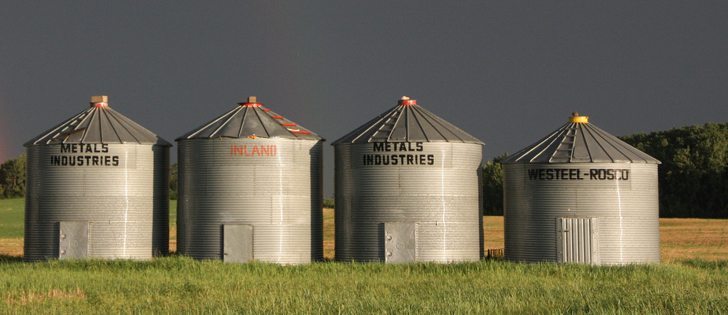Prairie producers will be augering billions of dollars worth of grain into storage bins across the West this year, often at remote and isolated bin sites.
That could prove to be an irresistible target for grain thieves, said Todd Heroux, a Saskatchewan grain and oilseed producer who lost nearly $60,000 worth of canola in 2010.
Like farmers, criminals will be looking to cash in on near-record commodity prices this year, he said. Producers who leave their grain accessible and unprotected could be in for a rude awakening.
Read Also

Bunge sells assets per merger approval
Bunge has sold five western Canadian elevators as required under the federal approval for its merger with Viterra.
“I think a lot of producers are very trusting people … and they don’t think it’s going to happen to them until it actually happens,” said Heroux. “I think we’re going to see more (grain thefts) this year and it’s a crime that’s very difficult for the RCMP to investigate because grain is grain. How do you identify yours from someone else’s?”
The theft at Heroux’s farm occurred early in the morning.
A neighbour saw two semi-trailers loading canola at Heroux’s bin site but assumed it was Heroux or a contracted carrier transporting the crop to the elevator.
Subsequent attempts to identify the thieves have been unsuccessful.
Heroux has since taken steps to secure his grain.
“We’re pretty careful now about where we put our grain,” he said.
“We also use grain confetti, we lock our bins and we make sure our (stored) grain is insured as well.”
Heroux said talking with neigh-bours and reporting suspicious activity can be a useful strategy.
“We weren’t the only ones (targeted) in the area so we’re taking kind of a neighbourhood watch approach now,” he said. “We’re keeping an eye on what’s going on out there and if there’s anything suspicious, we take it seriously.”
Grain confetti can be an effective deterrent. The product is easy to use, inexpensive and mixes well with grain as it is being binned.
“It’s very cost efficient, not even a cent a bushel,” he said.
Heroux will also be installing battery-operated, motion-activated surveillance cameras at his bin sites this year.
The cameras, along with related signs, are an effective deterrent and can be acquired for less than $200 from retailers that carry hunting equipment and outdoor sporting goods.
They are small, hard to detect and easy to install.
Doug Froehlich, a farmer from Marquis, Sask., agreed grain thefts could be more common this year.
In 2008, Froehlich lost 1,200 bushels of canola from a remote bin site, which cost him $16,000. He has since adopted simple precautions to deter thieves.
“Our more valuable crops are binned … closer to home or in areas that can be monitored more easily,” he said. “We also ensure that all bins have locks on them, although I’m not sure how much of a deterrent that is.”
Froehlich said farmers should give careful consideration to where they locate new bins.
If remote storage sites must be used, producers can block entrances with snow, trees, heavy machinery or fences.
Although official statistics aren’t kept on grain thefts, it is estimated that as many as 100 thefts of stored grain occur on the Prairies each year.
Rob King, an RCMP spokesperson in Regina, said grain is generally not something that thieves target.
Unlike most thefts that are committed on impulse, stealing grain requires equipment and premeditated planning.
“If you’re concerned about security of your property, lock it up, chain it down, hide it or else there’s a chance it will be stolen.”
















